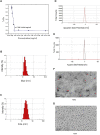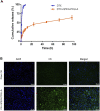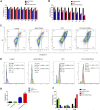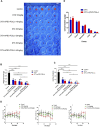mPEG-PDLLA Micelles Potentiate Docetaxel for Intraperitoneal Chemotherapy in Ovarian Cancer Peritoneal Metastasis
- PMID: 35462938
- PMCID: PMC9019464
- DOI: 10.3389/fphar.2022.861938
mPEG-PDLLA Micelles Potentiate Docetaxel for Intraperitoneal Chemotherapy in Ovarian Cancer Peritoneal Metastasis
Abstract
Ovarian cancer is the second most common cause of gynecological cancer death in women. It is usually diagnosed late and accompanied by peritoneal metastasis. For ovarian cancer with peritoneal metastasis, intraperitoneal (IP) chemotherapy can maintain a high drug concentration in the abdominal cavity and reduce local and systemic toxicity. Recently, docetaxel (DTX) has shown broad-spectrum antitumor activity against various malignant tumors, including ovarian cancer with peritoneal metastasis. However, DTX has limited clinical applications due to its poor water solubility, predisposition to hypersensitivity, fluid retention, and varying degrees of neurotoxicity. In this study, we prepared methoxy-poly(ethylene glycol)-block-poly(D,L-lactide) (mPEG-PDLLA) micelles loaded with DTX and developed an alternative, less toxic, more effective DTX formulation, without Tween 80, and evaluated its pharmacokinetics in the abdominal cavity and its efficacy in ovarian cancer with peritoneal metastasis. The mean diameter of DTX-mPEG-PDLLA was about 25 nm, and the pharmacokinetics of BALB/c mice via IP showed that the plasma exposure of DTX-mPEG-PDLLA was about four times lower than that of DTX. Importantly, DTX-mPEG-PDLLA was significantly more effective than DTX and prolonged the survival period in a SKOV-3 ovarian cancer peritoneal metastasis model. Moreover, the apoptosis rate was significantly increased in vitro. Based on these findings, it is expected that DTX-mPEG-PDLLA can enhance efficacy against ovarian cancer peritoneal metastasis, while reducing toxic side effects, and has the potential to be used in the clinical treatment of peritoneal metastatic cancer.
Keywords: DTX-mPEG-PDLLA micelles; intraperitoneal administration; ovarian cancer; peritoneal metastasis; pharmacokinetics.
Copyright © 2022 Zhang, Wang, Duan, Xu, Gao, Zhou, Xu and Li.
Conflict of interest statement
The authors declare that the research was conducted in the absence of any commercial or financial relationships that could be construed as a potential conflict of interest.
Figures







Similar articles
-
Novel Approach of Using Near-Infrared Responsive PEGylated Gold Nanorod Coated Poly(l-lactide) Microneedles to Enhance the Antitumor Efficiency of Docetaxel-Loaded MPEG-PDLLA Micelles for Treating an A431 Tumor.ACS Appl Mater Interfaces. 2017 May 10;9(18):15317-15327. doi: 10.1021/acsami.7b03604. Epub 2017 Apr 25. ACS Appl Mater Interfaces. 2017. PMID: 28418236
-
Drug-interactive mPEG-b-PLA-Phe(Boc) micelles enhance the tolerance and anti-tumor efficacy of docetaxel.Drug Deliv. 2020 Dec;27(1):238-247. doi: 10.1080/10717544.2020.1718245. Drug Deliv. 2020. PMID: 32003299 Free PMC article.
-
Arginine-stabilized mPEG-PDLLA (50/50) polymeric micelles of docetaxel by electrostatic mechanism for tumor-targeted delivery.Drug Deliv. 2015 Feb;22(2):168-81. doi: 10.3109/10717544.2013.849779. Epub 2013 Nov 12. Drug Deliv. 2015. PMID: 24215124
-
Synthesis, characterization and drug loading property of Monomethoxy-Poly(ethylene glycol)-Poly(ε-caprolactone)-Poly(D,L-lactide) (MPEG-PCLA) copolymers.Sci Rep. 2016 Sep 28;6:34069. doi: 10.1038/srep34069. Sci Rep. 2016. PMID: 27677842 Free PMC article.
-
Tumor microenvironment in ovarian cancer peritoneal metastasis.Cancer Cell Int. 2023 Jan 25;23(1):11. doi: 10.1186/s12935-023-02854-5. Cancer Cell Int. 2023. PMID: 36698173 Free PMC article. Review.
Cited by
-
Itraconazole Loaded Micelle Based on Methoxy Poly(Ethylene Glycol)-Poly(D, L-Lactic Acid) for Ocular Drug Delivery: In vitro and in vivo Evaluation.Int J Nanomedicine. 2025 May 22;20:6447-6462. doi: 10.2147/IJN.S521127. eCollection 2025. Int J Nanomedicine. 2025. PMID: 40420914 Free PMC article.
-
A novel form of docetaxel polymeric micelles demonstrates anti-tumor and ascites-inhibitory activities in animal models as monotherapy or in combination with anti-angiogenic agents.Front Pharmacol. 2022 Aug 24;13:964076. doi: 10.3389/fphar.2022.964076. eCollection 2022. Front Pharmacol. 2022. PMID: 36091776 Free PMC article.
-
Peritoneal chemotherapy delivery systems for ovarian cancer treatment: systematic review of animal models.Front Oncol. 2025 Jan 8;14:1487376. doi: 10.3389/fonc.2024.1487376. eCollection 2024. Front Oncol. 2025. PMID: 39845320 Free PMC article.
References
-
- Chen J., Jiang Z., Zhang Y. S., Ding J., Chen X. (2021). Smart Transformable Nanoparticles for Enhanced Tumor Theranostics. Appl. Phys. Rev. 8, 041321. 10.1063/5.0061530 - DOI
LinkOut - more resources
Full Text Sources
Other Literature Sources

